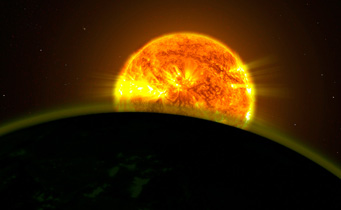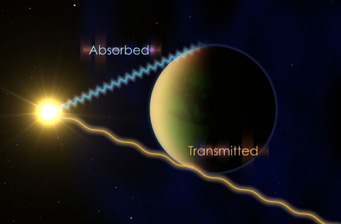Two teams have announced the discovery of water on alien worlds. But they found less water than expected, suggesting these planets are surrounded by a high-altitude haze.
Headlines last week touted the Hubble Space Telescope’s recent discovery of water on five gas giant planets. But detecting water was no surprise — the real find was an indirect glimpse at these planets’ high-altitude clouds.

NASA scientists found faint signatures of water in the atmospheres of five hot Jupiters. All five planets appear to have a high-altitude haze that weakens water's signal from deeper within their atmospheres.
NASA Goddard Space Flight Center
“No one doubted that water, a very common molecule, would exist in these atmospheres,” says David Charbonneau, a co-author on one of the two studies published in the Astrophysical Journal. And water has been found on exoplanets before, including in one of the planets in the study.
The real conclusion of the papers, Charbonneau says, is that the signature Hubble detected was weaker than expected. That discovery suggests a high-altitude haze absorbs the signal from water deeper in the atmosphere.
Two teams of scientists, who are working together to take a census of exoplanet atmospheres, aimed Hubble at five hot Jupiters, measuring their atmospheres’ absorption of starlight as the planets transited in front of their parent stars.
The five planets make up a diverse selection: WASP-12b was famously dubbed the “diamond planet” for its carbon-rich atmosphere, though the carbon is predominantly in carbon dioxide and methane form rather than diamonds. WASP-17b is likewise strange, known for its retrograde orbit and unusually low density, just one-sixth that of Jupiter’s. WASP-19b has one of the shortest periods among all known hot Jupiters. XO-1b has the distinction of being discovered in part by amateur astronomers. And finally, HD 209458b, the most-studied of the five hot Jupiters, was already known to host water vapor, strong winds, and high-altitude clouds.
All five planets orbit their parent stars tightly, swinging around once every few days (or in the case of WASP-19b, every 19 hours). That close interaction puffs up the planets’ atmospheres, and an extended atmosphere makes them ideal test cases for this kind of study.

When a transiting planet passes in front of its parent star, the thin shell of atmosphere that surrounds the opaque planet's bulk will be largely transparent to starlight. Molecules in the atmosphere absorb starlight at certain wavelengths, leaving a faint signature for Hubble to detect (after much data processing).
NASA Goddard Space Flight Center
The scientists homed in on wavelengths around 1.4 microns, where water’s molecular bonds absorb starlight. Water’s absorption signal is clear in HD 209458b; the signal is less clear in the other four planets, which will need additional observations. Surprisingly, the planets seem to have less water than scientists expected — they had to include a high-altitude clouds in their atmospheric models to match all the data.
If you take a look at the papers referenced below, you’ll find most of the papers cover the data analysis. This is a hard job: a transiting hot Jupiter intercepts only about 1% to 2% of its parent’s starlight, and of that, only a small sliver passes through the thin shell of atmosphere ringing the planet. And water will absorb only a small fraction of the photons that manage to pass through the thin shell. The team is working out how to use Hubble to explore atmospheres in all exoplanets, Charbonneau says, with the eventual goal of extending that analysis to Neptune-sized or even Earth-sized planets.
References:
Deming, D. et al. "Infrared Transmission Spectroscopy of the Exoplanets HD 209458b AND XO-1b Using the Wide Field Camera-3 on the Hubble Space Telescope." Astrophysical Journal, 2013 September 10. Full paper.
Mandell, A. et al. "Exoplanet Transit Spectroscopy Using WFC3: WASP-12b, WASP-17b, and WASP-19b." Astrophysical Journal, 2013 December 20. Full paper.
 0
0
Comments
You must be logged in to post a comment.